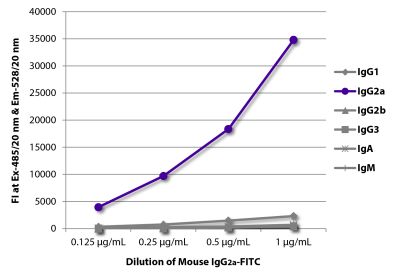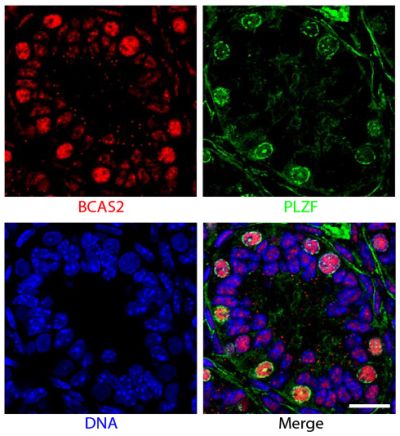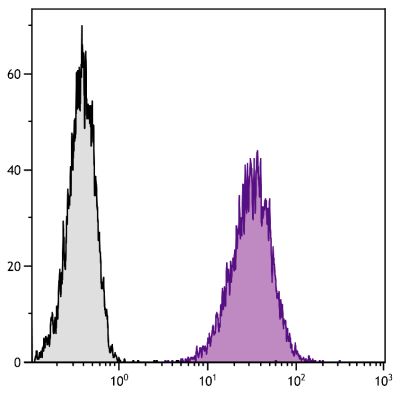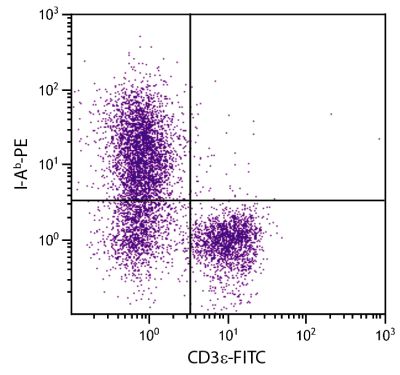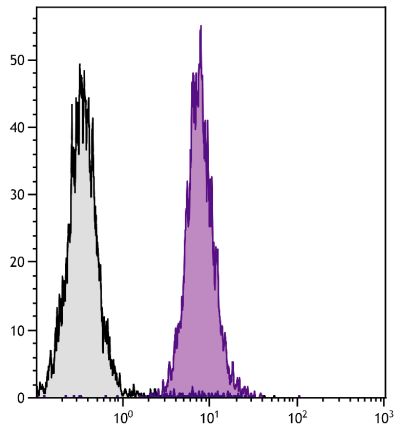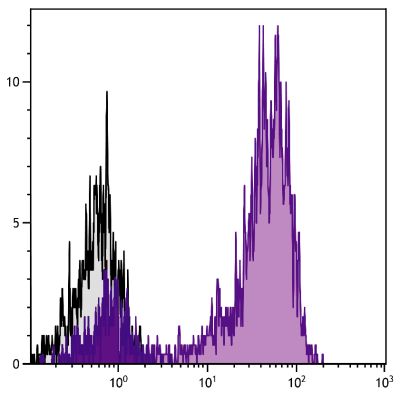Mouse Anti-Mouse H-2Db-FITC (28-14-8)
Cat. No.:
1910-02
FITC Anti-Mouse H-2Db antibody for use in flow cytometry and immunohistochemistry assays.
$307.00
| Clone | 28-14-8 |
|---|---|
| Isotype | Mouse (C3H) IgG2aκ |
| Isotype Control | Mouse IgG2a-FITC (HOPC-1) |
| Specificity | Mouse H-2Db |
| Alternative Names | MHC Class I |
| Description | The “classical” MHC Class I molecules are histocompatibility antigens encoded by the H-2 gene complex and consist of heterodimers of highly polymorphic α chains noncovalently associated with the invariant β2-microglobulin. These antigens are expressed on most nucleated cells but expression varies on different cell types. MHC Class I molecules present endogenously synthesized peptides to CD8+ T lymphocytes which are usually cytotoxic T cells. MHC Class I antigens expressed on thymic epithelial cells regulate the positive and negative selection of CD8+ T cells during T cell ontogeny. The monoclonal antibody 28-14-8 binds to the α3 domain of H-2Db in the presence or absence of β2 microglobulin. It cross reacts with the α3 domain of H-2Ld, but not Kd or Dd, and with H-2Dq and/or Lq. The antibody has been shown to block H-2Ld-specific and H-2Ld-restricted antigen-specific lysis of target cells by cytotoxic T lymphocytes but it does not block recognition of H-2Ld-positive target cells by Ly-6G2-positive NK cells. |
| Immunogen | C3H.SW mouse splenocytes |
| Conjugate | FITC (Fluorescein) |
| Buffer Formulation | Phosphate buffered saline containing < 0.1% sodium azide |
| Clonality | Monoclonal |
| Concentration | 0.5 mg/mL |
| Volume | 1.0 mL |
| Recommended Storage | 2-8°C; Avoid exposure to light |
| Applications |
Flow Cytometry – Quality tested 4,7,8 Immunohistochemistry-Frozen Sections – Reported in literature 4 Immunoprecipitation – Reported in literature 2,3 Blocking – Reported in literature 6 Complement Mediated Cell Depletion – Reported in literature 1,5,6 |
| RRID Number | AB_2795490 |
| Gene ID |
14964 (Mouse) |
| Gene ID Symbol |
H2-D1 (Mouse) |
| Gene ID Aliases | H-2D; H2-D; H2-K1 |
| UniProt ID |
P01899 (Mouse) |
| UniProt Name |
HA11_MOUSE (Mouse) |
Documentation
Certificate of Analysis Lookup
Enter the Catalog Number and Lot Number for the Certificate of Analysis you wish to view
- 1. Ozato K, Hansen TH, Sachs DH. Monoclonal antibodies to mouse MHC antigens. II. Antibodies to the H-2Ld antigen, the products of a third polymorphic locus of the mouse major histocompatibility complex. J Immunol. 1980;125:2473-7. (Immunogen, CMDC)
- 2. Allen H, Fraser J, Flyer D, Calvin S, Flavell R. β2-microglobulin is not required for cell surface expression of the murine class I histocompatibility antigen H-2Db or of a truncated H-2Db. Proc Natl Acad Sci USA. 1986;83:7447-51. (IP)
- 3. Lie W, Myers NB, Connolly JM, Gorka J, Lee DR, Hansen TH. The specific binding of peptide ligand to Ld class I major histocompatibility complex molecules determines their antigenic structure. J Exp Med. 1991;173:449-59. (IP)
- 4. Levitsky HI, Lazenby A, Hayashi RJ, Pardoll DM. In vivo priming of two distinct antitumor effector populations: the role of MHC class I expression. J Exp Med. 1994;179:1215-24. (FC, IHC-FS)
- 5. Ozato K, Sachs DH. Monoclonal antibodies to mouse MHC antigens. III. Hybridoma antibodies reacting to antigens of the H-2b haplotype reveal genetic control of isotype expression. J Immunol. 1981;126:317-21. (Immunogen, CMDC)
- 6. Woodward JG, Örn A, Harmon RC, Goodenow RS, Hood L, Frelinger JA. Specific recognition of the product of a transferred major histocompatibility complex gene by cytotoxic T lymphocytes. Proc Natl Acad Sci USA. 1982;79:3613-7. (CMDC, Block)
- 7. Wang R, Rogers AM, Ratliff TL, Russell JH. CD95-dependent bystander lysis caused by CD4+ T helper 1 effectors. J Immunol. 1996;157:2961-8. (FC)
- 8. Lee S, Bar-Haim E, Machlenkin A, Goldberger O, Volovitz I, Vadai E, et al. In vivo rejection of tumor cells dependent on CD8 cells that kill independently of perforin and FasL. Cancer Gene Ther. 2004;11:237-48. (FC)
See More


